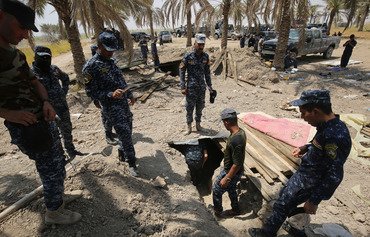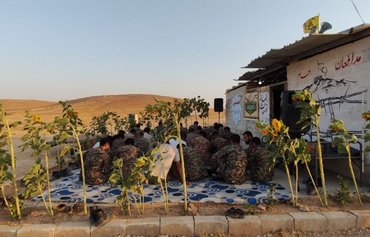Tunnel networks are one of the tools of warfare used by the "Islamic State of Iraq and Syria" (ISIS), specifically designed for manoeuvering and hiding from aerial surveillance and to serve as escape routes when defeat is imminent.
The tunnels often include complex underground routes and are equipped with lighting and stocked with food supplies so they can be used as temporary living quarters.
To keep their existence a secret, the entrances are placed at points that do not raise suspicion, such as houses or public buildings, and are camouflaged and booby-trapped to deter intruders.
During their advance to liberate Mosul, Iraqi forces destroyed dozens of such tunnels, most recently in the village of Halila to the west of the city.
During the group's occupation of the village, ISIS elements built a tunnel network and a command and control centre there, taking advantage of the area's numerous hills and rough, unpaved roads.
In an April 21st statement, the Iraqi Ministry of Defence revealed that ISIS used the tunnels to "move from one area to another and evade airstrikes".
ISIS had been preparing to repel the advance of the Iraqi forces with about 14 car bombs and ambushes sprung from these tunnels, the statement said.
The Iraqi Army’s 9th Armoured Division was able to pre-empt these attacks, however, destroy the group's defences and secure the entire village.
ISIS goes underground
ISIS relies on three main combat strategies -- car bombs, suicide bombers and tunnel networks -- said Ninawa Operations Command Chief of Staff Brig. Gen. Raad Mahmoud.
"In the course of our battles, we discovered several networks, mostly in the east and south of Mosul," he said. "The most complex of those networks were the ones we discovered in the town of al-Qayyarah and Ninawa plain areas."
The group takes advantage of the "complex geographical terrain and population density" in selecting sites for its fortified tunnels, Mahmoud said.
On December 27th, military forces discovered the "largest tunnel network" in east Mosul, which was several kilometres long and up to 10 metres deep.
It was being used as a shelter and was equipped with electricity, refrigerators, food and water, and contained sleeping and living quarters.
Mahmoud said ISIL dug these tunnels either manually, using simple tools, or by using excavators and bulldozers.
Where these tunnels were dug manually, he said, "it is not unlikely that they used prisoners to perform this arduous labour".
The mechanical method, using heavy equipment, was more commonly used in the construction of deep tunnels that stretched for long distances, he said.
Secret tunnels are last resort
The construction of the tunnels was not done haphazardly as factors such as the type of soil, route engineering, previously excavated slots and the main purpose for the particular tunnel were taken into account.
Some were used for hiding or escape routes, while others were used as storage for ammunition, weapons and improvised explosive devices (IEDs), said Ninawa provincial council security committee chairman Mohammed Ibrahim.
This type of tunnel was discovered in west Mosul, in the Wadi Hajar district, near al-Ghazlani camp and in the hills around Albu Seif village, he told Diyaruna.
Ibrahim said the group used machines and equipment that belong to the municipality and are used in laying water and sewer lines to dig out the tunnels.
ISIS, which still controls a small section inside Mosul, is trying to use household basements as secret tunnels, he added.
"Our intelligence information confirms that ISIS built networks and passageways connecting one alley to another in the Old City and 17 Tamuz district as part of its effort to prolong the fighting in its last strongholds in Mosul," he said.
And yet, the tunnels could not help ISIS avert defeat, said Ninawa provincial council member Banyan al-Jarba, adding that Iraqi forces "have gained enough experience and skill to fight the terrorists above and below ground".
"This strategy ultimately has proven to be an abject failure, as all the tunnels the enemy built in Mosul, and bet on their effectiveness, have now been destroyed and many of them have become graves for its elements," he said.

![Iraqi soldiers inspect one of the largest 'Islamic State of Iraq and Syria' tunnel networks, discovered in east Mosul at the end of 2016. [Photo from the Military Intelligence Division Facebook page]](/cnmi_di/images/2017/05/12/7813-Iraq-ISIS-tunnel-600_384.jpg)





